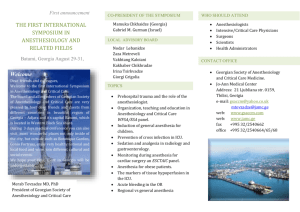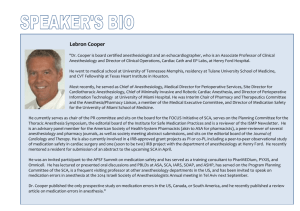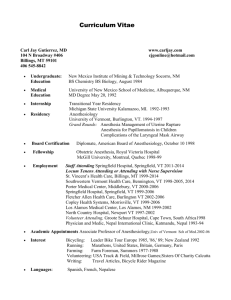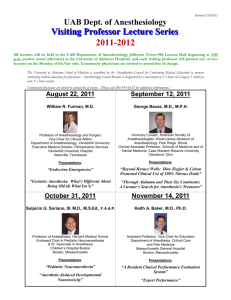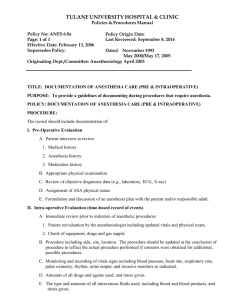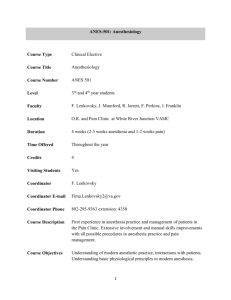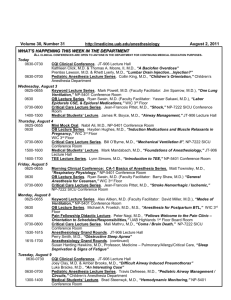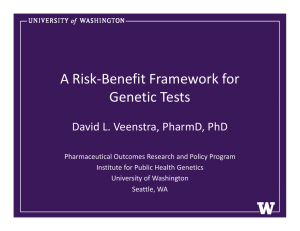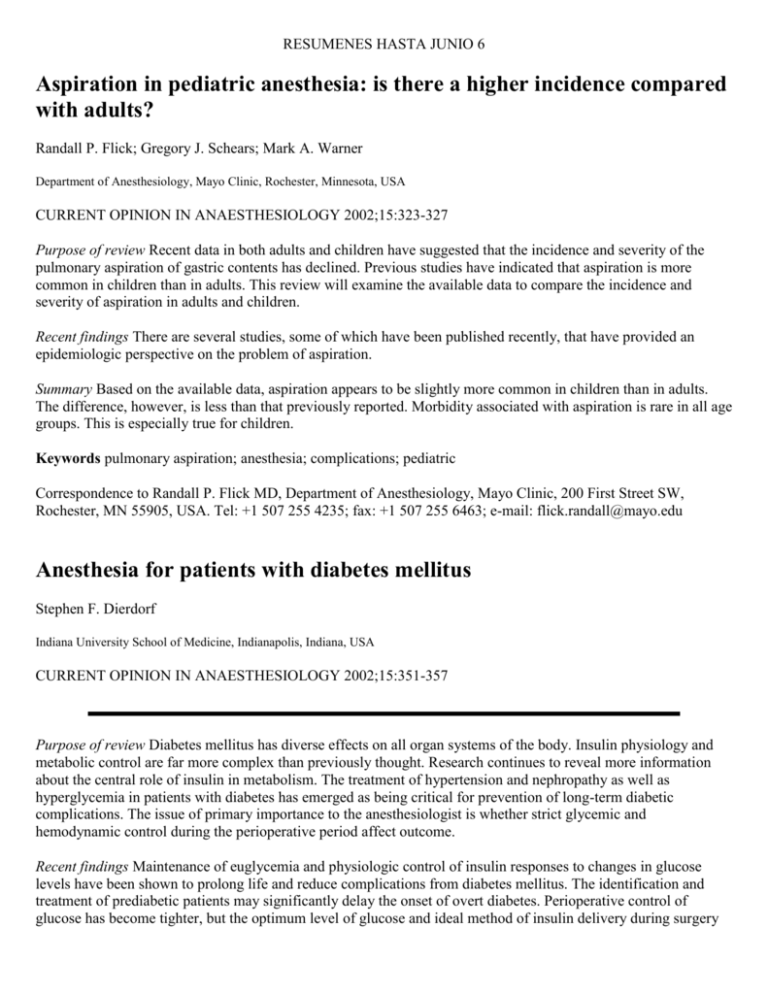
RESUMENES HASTA JUNIO 6
Aspiration in pediatric anesthesia: is there a higher incidence compared
with adults?
Randall P. Flick; Gregory J. Schears; Mark A. Warner
Department of Anesthesiology, Mayo Clinic, Rochester, Minnesota, USA
CURRENT OPINION IN ANAESTHESIOLOGY 2002;15:323-327
Purpose of review Recent data in both adults and children have suggested that the incidence and severity of the
pulmonary aspiration of gastric contents has declined. Previous studies have indicated that aspiration is more
common in children than in adults. This review will examine the available data to compare the incidence and
severity of aspiration in adults and children.
Recent findings There are several studies, some of which have been published recently, that have provided an
epidemiologic perspective on the problem of aspiration.
Summary Based on the available data, aspiration appears to be slightly more common in children than in adults.
The difference, however, is less than that previously reported. Morbidity associated with aspiration is rare in all age
groups. This is especially true for children.
Keywords pulmonary aspiration; anesthesia; complications; pediatric
Correspondence to Randall P. Flick MD, Department of Anesthesiology, Mayo Clinic, 200 First Street SW,
Rochester, MN 55905, USA. Tel: +1 507 255 4235; fax: +1 507 255 6463; e-mail: flick.randall@mayo.edu
Anesthesia for patients with diabetes mellitus
Stephen F. Dierdorf
Indiana University School of Medicine, Indianapolis, Indiana, USA
CURRENT OPINION IN ANAESTHESIOLOGY 2002;15:351-357
Purpose of review Diabetes mellitus has diverse effects on all organ systems of the body. Insulin physiology and
metabolic control are far more complex than previously thought. Research continues to reveal more information
about the central role of insulin in metabolism. The treatment of hypertension and nephropathy as well as
hyperglycemia in patients with diabetes has emerged as being critical for prevention of long-term diabetic
complications. The issue of primary importance to the anesthesiologist is whether strict glycemic and
hemodynamic control during the perioperative period affect outcome.
Recent findings Maintenance of euglycemia and physiologic control of insulin responses to changes in glucose
levels have been shown to prolong life and reduce complications from diabetes mellitus. The identification and
treatment of prediabetic patients may significantly delay the onset of overt diabetes. Perioperative control of
glucose has become tighter, but the optimum level of glucose and ideal method of insulin delivery during surgery
remain controversial. Perioperative control of blood pressure and vascular responses may be as important as
glucose control for prevention of adverse perioperative events.
Summary Tight long-term control of glucose and blood pressure improve outcome in patients with diabetes. The
same philosophy of management is being applied to the perioperative period. Routine measurement of
intraoperative blood glucose levels and appropriate insulin administration are now standard practice, but the ideal
regimen for insulin administration remains to be determined.
Keywords diabetes mellitus; anesthesia; diabetic nephropathy
Nitrous oxide does not improve sevoflurane induction of anesthesia in adults
C. Siau a *
AE.H.C. Liu a †
Singapore 119074.
A Address correspondence and requests for reprints to Dr. Siau at the Department of Anesthesia, National University
Hospital, 5 Lower Kent Ridge Road,
[a]Department of Anesthesia, National University Hospital, Singapore
Manuscript received 4 October 2001 Revised 30 January 2002 Accepted 30 January 2002;
Study Objective: To compare the characteristics of sevoflurane induction with and without the addition of nitrous
oxide (N2O) using tidal breathing inhalation induction without priming of the breathing circuit.
Design: Randomized, double-blind study.
Setting: Operating rooms of an ambulatory surgery suite at a university hospital.
Patients: 60 ASA physical status I and II adult patients undergoing elective surgery.
Interventions: Patients were randomized into two groups. During induction, Group 1 received 8% sevoflurane
in N2O 4L/min and oxygen (O2) 2L/min; Group 2 received 8% sevoflurane in O2 6L/min. The time to cessation
of finger tapping was used as the main index for induction time. Any adverse effects such as coughing,
apnea, excessive oral secretions, laryngospasm, excitatory movements, and hemodynamic changes were
also noted.
Measurements and Main Results: There were no significant differences in the induction times (Group 1: 62.0
vs. Group 2: 60.0 sec), number of breaths taken to this time (15.0 vs. 14.0), expired sevoflurane
concentration at this time (3.4 vs. 3.2%), and time to Laryngeal Mask Airway insertion (160.0 vs. 195.0
sec). The frequencies of induction-related adverse events were similar in both study groups.
Conclusion: The addition of N2O does not confer any clinically significant advantage in this method of
sevoflurane induction in adults.
Pain Medicine
Volume 3 Issue 1 Page 39 - March 2002
Does the Conscious Exaggeration Scale Detect Deception Within Patients with
Chronic Pain Alleged to Have Secondary Gain?
David A. Fishbain, MSc, MD, FAPA,* Robert B. Cutler, PhD,* Hubert L. Rosomoff, MD, DMedSc, and Renee Steele-Rosomoff, BSN, MBA
Objectives.The illness behavior questionnaire (IBQ) is a test battery developed by Pilowsky to detect what he has termed
abnormal illness behavior, which includes malingering [4]. The IBQ has been widely utilized in patients with chronic pain
(PWCP). Clayer developed a 21-item scale out of the IBQ, which he termed the conscious exaggeration (CE) scale [7]. He
proposed that the CE scale could detect conscious deception, i.e., malingering. The purpose of the present study is to test
the CE scale in PWCP alleged to have secondary gain and thereby at greater risk for poor pain treatment outcome. It was
postulated that the CE scale should generate scores in these groups significantly different from a comparison group and
should predict treatment outcome in the secondary gain groups.
Design.A total of 96 PWCP completed the CE scale at admission and after completion of a 1-month pain facility treatment
regimen. Other relevant pain variables, such as pain, depression, and anxiety, were measured and the data collected at
admission and treatment completion. Work status was determined at 1, 3, 6, 12, 18, 24, and 30 months posttreatment.
PWCP secondary gain subgroups (Workers' Compensation patients, patients in litigation, patients having a lawyer) were
compared to the comparison group (no secondary gain factors) for treatment CE scale change scores. In order to control
for the effects of pain, an analysis of covariance with pain level statistically removed was performed on admission and
discharge CE scores utilizing the above patient subgroups. Pearson product correlations were utilized to determine the
relationships between CE scores and psychological variables. Stepwise regression analyses were utilized to predict return
to work with the CE scale score as a potential predictor.
Setting.Pain facility.
Patients.PWCP treated for 1 month in a pain facility.
Results.Overall, the analyses did not support the main hypothesis. For example, CE scale scores did not predict return to
work. There was a significant degree of correlation between the variables of pain, depression, anxiety, and CE scale
scores.
Conclusions.PWCP characterized by the alleged secondary gain variables of Workers' compensation status, litigation,
and having a lawyer did not differentially respond to the CE scale versus the comparison group. The CE scale, therefore,
does not appear to be a valid instrument for identifying exaggeration in PWCP
Pain Medicine
Volume 3 Issue 1 Page 56 - March 2002
How Well is Chronic Pain Managed? Who Does it Well?
Carmen R. Green, MD, John R.C. Wheeler, PhD,* Frankie LaPorte, BS, Beverly Marchant, RN, and Eloisa Guerrero, PhD
Background.The variability in physician attitudes and goals for chronic pain relief and satisfaction with chronic pain
management is unknown.
Objectives.To provide quantitative data regarding the status of chronic pain management by Michigan physicians. To
relate physician's goals for pain management to physician confidence, preferences, and satisfaction with their chronic pain
care.
Research Design.A prospective cohort study utilizing a survey with four chronic pain vignettes.
Subjects.Three hundred and sixty-eight Michigan physicians who provide clinical care.
Measures.Evaluate differences in chronic pain decision making based upon physician demographic characteristics,
knowledge, and attitudes.
Results.The respondents reported a high frequency of treating patients with chronic pain. However, many expressed
generally low satisfaction and confidence in their treatment of chronic pain, as well as low goals for the relief of chronic
pain. A large number of respondents selected the worst or a poor treatment option for the chronic pain vignettes. In
particular, prescriptions of opioid analgesics were infrequent. Younger physicians and those with pain education were more
likely to choose the best responses to the vignettes.
Conclusion.Low pain relief goals and satisfaction with the management of chronic pain suggests the potential for its
undertreatment. Our data highlight the variability in pain decision making and provide insight into the educational needs of
physicians regarding chronic pain management.
European Journal of Pain
Tables of Contents and Abstracts Online Issue Contents
Children's pain at home following (adeno) tonsillectomy
Jan P.H. Hamers, Huda Huijer Abu-Saad
p 213-219, Volume 6, Number 3, May 2002
Abstract
The aim of this study was to evaluate the prevalence and severity of children's pain at home following (adeno)tonsillectomies.
The subjects were parents of 161 children (86 boys, 75 girls) undergoing myringotomies, adenoidectomies and
(adeno)tonsillectomies. The mean age of the children was 5.5 years (SD=2.4; range 1-14). Parents were asked to assess the
child's average pain on the day of operation and 7 days after the operation, using a 100 mm Visual Analogue Scale (VAS).
Parents from (adeno)tonsillectomy patients were also interviewed by phone on day 7.
The mean VAS pain intensity scores by period (day of operation until 7th day after operation) differed between the
myringotomy (3.2), adenoidectomy (10.6), and (adeno)tonsillectomy (22.1) group (F2,133=31.65; p<0.001). The VAS ratings
were highest for the tonsillectomy group (p <0.001). There was a trend that pain intensity scores for adenoidectomies were
significantly higher than scores for myringotomies (p=0.07). In the interviews, 81% of the parents stated that their child
suffered pain at home. However, this was not necessarily a reason to administer an analgesic. Furthermore, parents reported
pain-related problems like problems regarding eating, fluid intake, vomiting and sleep disturbance. Finally, 67% of the
children at home recalled severe pain experience in the hospital.
It was concluded that especially following (adeno)tonsillectomies children suffer clinically significant pain at home and that the
management of pain and related problems needs to be clearly improved. Copyright 2002 European Federation of Chapters of
the International Association for the Study of Pain. Published by Elsevier Science Ltd. All rights reserved.
Keywords
pain, (adeno)tonsillectomy, home, children
Postoperative Cognitive Dysfunction in Middle-aged Patients
Tim Johnson, F.R.C.A.
*; Terri Monk, M.D.†; Lars S. Rasmussen, M.D.‡; Hanne Abildstrom, M.D.§; Peter Houx, Ph.D.||; Kari Korttila,
M.D.#; Harrie M. Kuipers**; Chris D. Hanning, M.D.††; Volkert D. Siersma, M.T.D.‡‡; Diana Kristensen,
M.D.§§; Jaume Canet, M.D.||||; Maria Teresa Ibañaz, M.D.##; Jakob T. Moller, M.D.***; for the ISPOCD2
Investigators†††
ANESTHESIOLOGY 2002;96:1351-1357
Background: Postoperative cognitive dysfunction (POCD) after noncardiac surgery is strongly associated with
increasing age in elderly patients; middle-aged patients (aged 40–60 yr) may be expected to have a lower
incidence, although subjective complaints are frequent.
Methods: The authors compared the changes in neuropsychological test results at 1 week and 3 months in patients
aged 40–60 yr, using a battery of neuropsychological tests, with those of age-matched control subjects using Zscore analysis. They assessed risk factors and associations of POCD with measures of subjective cognitive
function, depression, and activities of daily living.
Results: At 7 days, cognitive dysfunction as defined was present in 19.2% (confidence interval [CI], 15.7–23.1) of
the patients and in 4.0% (CI, 1.6–8.0) of control subjects (P < 0.001). After 3 months, the incidence was 6.2% (CI,
4.1–8.9) in patients and 4.1% (CI, 1.7–8.4) in control subjects (not significant). POCD at 7 days was associated
with supplementary epidural analgesia and reported avoidance of alcohol consumption. At 3 months, 29% of
patients had subjective symptoms of POCD, and this finding was associated with depression. Early POCD was
associated with reports of lower activity scores at 3 months.
Conclusions: Postoperative cognitive dysfunction occurs frequently but resolves by 3 months after surgery. It may
be associated with decreased activity during this period. Subjective report overestimates the incidence of POCD.
Patients may be helped by recognition that the problem is genuine and reassured that it is likely to be transient.
*Consultant, Hope Hospital. †Professor, University of Florida College of Medicine. ‡Consultant, §Research Assistant, ***Chair,
Copenhagen University Hospital, Rigshospitalet. ||Associate Professor, Rijk-universiteit Limburg. #Professor, Department of Anaesthesia
and Intensive Care, University of Helsinki. **Eindhoven University of Technology. †† Consultant, Leicester General Hospital.
‡‡Research Assistant, Department of Biostatistics, University of Copenhagen. §§Research Fellow, Hillerød Hospital. ||||Consultant,
Hospital Universitari Germans Trias I Pujol. ##Staff Anesthesiologist, Hospital General Elche. †††A listing of the ISPOCD2 investigators
appears in the Appendix. Received from Hope Hospital, Salford, United Kingdom, University of Florida College of Medicine,
Gainesville, Florida, Copenhagen University Hospital, Rigshospitalet, Copenhagen, Denmark, Rijks-universiteit Limburg, Maastrict,
Netherlands, Department of Anaesthesia and Intensive Care, University of Helsinki, Helsinki, Finland, Eindhoven University of
Technology, Eindhoven, Netherlands, Leicester General Hospital, Leicester, United Kingdom, Department of Biostatistics, University of
Copenhagen, Denmark, Hillerød Hospital, Denmark, Hospital Universitari Germans Trias i Pujol, Barcelona, and Hospital General Elche,
Alicante, Spain.
Received for publication August 2, 2001.
Accepted for publication January 2, 2002.
The collaborative parts of the project were funded by a European Union Biomed 2 grant No. BMH4-98-3335, Rue de la Loi, B-1049
Brussels, Belgium. Individual data collection centers received funding from the following organizations: Denmark–Copenhagen:
Forskningsstyrelsen, H:S Forskningsfond, Direktør Jacob Madsen og hustrus Olga Madsens Fond, Rigshospitalets Jubilæumsfond, DK2100, Copenhagen, Denmark; Hillerød: Oberstinde Jensa La Cours Fond, Forskningsfonden for Frederiksborg Amt, DK-3400 Hillerød,
Denmark. Finland–Helsinki: HUS-EVO grants TYH 0051 and TYH 0324, FIN-00029 HUS, Finland. United Kingdom–Leicester:
Research into Ageing, London, United Kingdom. Spain–Barcelona: Fondo de Investigaciones Sanitarias (FIS) Spain, Grant 01/0633,
Fundació per a la Recerca Biomédica Germans Trias i Pujol, Badalona, Spain. United States–Anesthesia Patient Safety Foundation,
Pittsburgh, Pennsylvania; I Heeman Anesthesia Foundation Inc., Gainesville, Florida.
Address reprint requests to Dr. Johnson: Department of Anaesthesia, Hope Hospital, Stott Lane, Salford M6 8HD, United Kingdom.
Address electronic mail to: tim.johnson@hope.srht.nwest.nhs.uk. Individual article reprints may be purchased through the Journal Web
site, www.anesthesiology.org.
Gastric Emptying of Water in Term Pregnancy
Cynthia A. Wong, M.D.
*; Mariann Loffredi, M.D.†; Jeanne N. Ganchiff, R.N., M.P.H.‡; Jia Zhao, B.S.§; Zhao Wang, M.D.||; Michael J.
Avram, Ph.D.#
Presented in part at the annual meeting of the American Society of Anesthesiologists, San Francisco, California,
October 17, 2000.
ANESTHESIOLOGY 2002;96:1395-1400
Background: Healthy nonpregnant patients may ingest clear liquids until 2 h before induction of anesthesia
without adversely affecting gastric volume. The purpose of this study was to compare gastric emptying in term,
nonlaboring pregnant women after ingestion of 50 ml water (control) with that after ingestion of 300 ml water.
Methods: Gastric emptying was assessed in healthy, nonobese, term pregnant volunteers using both serial gastric
ultrasound examinations (n = 9) and acetaminophen absorption (n = 11) in a crossover study design. After an
overnight fast, volunteers ingested 1.5 g acetaminophen and 50 or 300 ml water (assigned in random order) on two
occasions separated by at least 2 days. Serial gastric antrum cross-sectional areas were determined using gastric
ultrasound imaging, and the half-time to gastric emptying was calculated. Serial plasma acetaminophen
concentrations were measured. Areas under the plasma acetaminophen concentration versus time curve, peak
concentrations, and time to peak concentration for 50- and 300-ml ingestions were compared.
Results: Gastric emptying half-time was significantly shorter after ingestion of 300 ml water than after ingestion of
50 ml (24 ± 6 vs. 33 ± 8 min). There were no differences in acetaminophen areas under the curve at 60, 90, or 120
min, or in acetaminophen peak concentration. Time to peak concentration of acetaminophen was significantly
shorter after ingestion of 300 ml water than after ingestion of 50 ml (25 ± 12 vs. 41 ± 19 min).
Conclusions: Gastric emptying in healthy, term, nonobese, nonlaboring pregnant women is not delayed after
ingestion of 300 ml water compared with that after an overnight fast.
*Assistant Professor, ‡Clinical Nurse Specialist, § Research Technician, ||Research Associate, #Associate Professor. † Staff
Anesthesiologist; current position: Georgia Perioperative Consultants, Atlanta, Georgia. Received from the Department of
Anesthesiology, Northwestern University Medical School, Chicago, Illinois.
Submitted for publication October 1, 2001.
Accepted for publication February 7, 2002.
Supported in part by a grant from the Northwestern Memorial Foundation, Chicago, Illinois.
Address reprints requests to Dr. Wong: Department of Anesthesiology, 251 East Huron, Olson 7428, Chicago, Illinois 60611. Address
electronic mail to: c-wong2@northwestern.edu. Individual article reprints may be purchased through the Journal Web site,
www.anesthesiology.org.
Kinetics of Isotonic and Hypertonic Plasma Volume Expanders
Dan Drobin, M.D., Ph.D.*; Robert G. Hahn, M.D., Ph.D.†
ANESTHESIOLOGY 2002;96:1371-1380
Background: Major differences in plasma volume expansion between infusion fluids are fairly well known, but
there is a lack of methods that express their dynamic properties. Therefore, a closer description enabled by kinetic
modeling is presented.
Methods: Ten healthy male volunteers received, on different occasions, a constant-rate intravenous infusion over
30 min consisting of 25 ml/kg of 0.9% saline, lactated Ringer’s solution, acetated Ringer’s solution, 5 ml/kg of
7.5% saline, or 3 ml/kg of 7.5% saline in 6% dextran. One-, two-, and three-volume kinetic models were fitted to
the dilution of the total venous hemoglobin concentration over 240 min. Osmotic fluid shifts were considered when
hypertonic fluid was infused.
Results: All fluids induced plasma dilution, which decreased exponentially after the infusions. The ratio of the area
under the dilution-time curve and the infused fluid volume showed the following average plasma-dilution doseeffect (efficiency), using 0.9% saline as the reference (= 1): lactated Ringer’s solution, 0.88; acetated Ringer’s
solution, 0.91; hypertonic saline, 3.97; and hypertonic saline in dextran, 7.22 (“area approach”). Another
comparison, based on kinetic analysis and simulation, showed that the strength of the respective fluids to dilute the
plasma by 20% within 30 min was 0.94, 0.97, 4.44, and 6.15 (“target dilution approach”). Between-subject
variability was approximately half as high for the latter approach.
Conclusions: The relative efficiency of crystalloid infusion fluids differs depending on whether the entire dilutiontime profile or only the maximum dilution is compared. Kinetic analysis and simulation is a useful tool for the
study of such differences.
*Assistant Professor and †Professor, Department of Anesthesiology, Söder Hospital. Received from the Department of Anesthesiology,
Söder Hospital, Stockholm, Sweden.
Submitted for publication December 1, 2000.
Accepted for publication January 23, 2002.
Financial support was provided from departmental sources and from the Swedish Research Council (project 10853).
Address reprint requests to Dr. Drobin: Department of Anesthesiology, Söder Hospital, S-118 83 Stockholm, Sweden. Address electronic
mail to: drobin@algonet.se. Individual article reprints may be purchased through the Journal Web site, www.anesthesiology.org.
Acute Normovolemic Hemodilution Improves Oxygenation in Ischemic
Flap Tissue
Sören Schramm, M.D.*; Reto Wettstein, M.D.*; Robert Wessendorf, M.D.*; Stephan M. Jakob, M.D.†; Andrej
Banic, M.D., Ph.D.‡; Dominique Erni, M.D.§
ANESTHESIOLOGY 2002;96:1478-1484
Background: The flaps used in reconstructive surgery are prone to ischemia and hypoxia, which imply a
considerable risk of wound-healing complications. During normovolemic hemodilution, the oxygenation may
further deteriorate because of the lack of erythrocytes or improve because of increased microcirculatory blood
flow. The aim of this study was to investigate the net effect of normovolemic hemodilution of various degrees on
the microcirculation and oxygenation in ischemic flap tissue in adult minipigs.
Methods: A rectangular flap was raised in the middle of the epigastrium, consisting of an adequately perfused
portion and a partly ischemic portion. The animals were randomly assigned to either the control group (n = 10) or
the experimental group (n = 10) receiving graded normovolemic hemodilution with 6% hydroxyethyl starch 200–
0.5.
Results: Normovolemic hemodilution caused a significant linear increase in total blood flow to the flap (measured
by transit time flowmetry). In the ischemic flap tissue, both oxygen tension (measured by polarographic cells) and
venous base excess were transiently improved during hemodilution (F = 4.79 and P = 0.019 for the regression of
tissue oxygen tension on hemoglobin and hemoglobin squared, and F = 4.18 and P = 0.029 for base excess). The
expected values reached a peak at hemoglobin concentrations of 9.1 and 8.5 g/dl, respectively. The measured
values at this level of hemodilution were 17 ± 10.7 mmHg (mean ± SD) versus 7.6 ± 1.9 mmHg (baseline) for
oxygen tension and –1.7 ± 3.4 versus –5.6 ± 4.1 mM for venous base excess.
Conclusions: Our results suggest that the oxygenation in ischemic and hypoxic flap tissue may be improved by
normovolemic hemodilution. The maximal benefit may be expected at a hemoglobin concentration at or slightly
less than 9 g/dl.
*Research Fellow, ‡Professor, §Consultant, Division of Plastic and Reconstructive Surgery. †Senior Resident, Department of
Anesthesiology and Intensive Care. Received from the Division of Plastic and Reconstructive Surgery, Inselspital University Hospital,
Berne, Switzerland.
Chlorhexidine Compared with Povidone-Iodine Solution for Vascular Catheter–Site Care: A MetaAnalysis
Nathorn Chaiyakunapruk, PharmD, PhD; David L. Veenstra, PharmD, PhD; Benjamin A. Lipsky, MD; and
Sanjay Saint, MD, MPH
Pages 792-801
Purpose: Bloodstream infections related to use of catheters, particularly central-line catheters, are an important
cause of patient morbidity, mortality, and increased health care costs. This study evaluated the efficacy of skin
disinfection with chlorhexidine gluconate compared with povidone-iodine solution in preventing catheter-related
bloodstream infection.
Data Sources: Multiple computerized databases (1966 to 2001), reference lists of identified articles, and queries of principal
investigators and antiseptic manufacturers.
Study Selection: Randomized, controlled trials comparing chlorhexidine gluconate with povidone-iodine solutions for
catheter-site care.
Data Extraction: Using a standardized form, two reviewers abstracted data on study design, patient population,
intervention, and incidence of catheter-related bloodstream infection from all included studies.
Data Synthesis: Eight studies involving a total of 4143 catheters met the inclusion criteria. All studies were conducted in a
hospital setting, and various catheter types were used. The summary risk ratio for catheter-related bloodstream infection was
0.49 (95% CI, 0.28 to 0.88) in patients whose catheter sites were disinfected with chlorhexidine gluconate instead of
povidone-iodine. Among patients with a central vascular catheter, chlorhexidine gluconate reduced the risk for catheterrelated bloodstream infection by 49% (risk ratio, 0.51 [CI, 0.27 to 0.97]).
Conclusions: These results suggest that incidence of bloodstream infections is significantly reduced in patients with central
vascular lines who receive chlorhexidine gluconate versus povidone-iodine for insertion-site skin disinfection. Use of
chlorhexidine gluconate is a simple and effective means of reducing vascular catheter–related infections.
Ann Intern Med. 2002;136:792-801.
Author and Article Information
From Naresuan University, Pitsanuloak, Thailand; University of Washington and Veterans Affairs Puget Sound Healthcare
System, Seattle, Washington; and University of Michigan and Ann Arbor Veterans Administration Medical Center, Ann Arbor,
Michigan.
Acknowledgments: The authors thank Gerard Sheehan, MD, John M. Conly, MD, Raphaele Girard, MD, Angela LeBlanc,
BSc (Hed), and Valerie Knasinski, RN, for providing citations of additional studies or additional information from their studies.
They also thank Todd A. Lee, PharmD, PhD, for helping with the abstraction of these studies.
Requests for Single Reprints: David L. Veenstra, PharmD, PhD, Pharmaceutical Outcomes Research and Policy Program,
Department of Pharmacy, Box 357630, University of Washington, Seattle, WA 98195-7630; e-mail,
veenstra@u.washington.edu.
Current Author Addresses: Dr. Chaiyakunapruk: Department of Pharmacy Practice, School of Pharmacy, Naresuan
University, Pitsanuloak 65000, Thailand.
Dr. Veenstra: Pharmaceutical Outcomes Research and Policy Program, Box 357630, University of Washington, Seattle, WA
98195-7630 .
Dr. Lipsky: Veterans Affairs Puget Sound Health Care System (S-111-GIMC), 1660 South Columbian Way, Seattle, WA
98108-1597.
Dr. Saint: University of Michigan Medical School, Room 7E08, 300 NIB, Campus Box 0429, Ann Arbor, MI 48109-0429.
Author Contributions: Conception and design: D.L. Veenstra, S. Saint.
Analysis and interpretation of the data: N. Chaiyakunapruk, D.L. Veenstra, B.A. Lipsky, S. Saint.
Drafting of the article: N. Chaiyakunapruk, B.A. Lipsky.
Critical revision of the article for important intellectual content: N. Chaiyakunapruk, D.L. Veenstra, B.A. Lipsky, S. Saint.
Final approval of the article: N. Chaiyakunapruk, D.L. Veenstra, B.A. Lipsky, S. Saint.
Statistical expertise: N. Chaiyakunapruk, D.L. Veenstra.
Obtaining of funding: D.L. Veenstra, S. Saint.
Administrative, technical, or logistic support: N. Chaiyakunapruk.
Collection and assembly of data: N. Chaiyakunapruk.
Keywords: Chlorhexidine; Povidone-iodine; Catheterization, central venous; Sepsis; Disinfection
The Wrong Patient
Mark R. Chassin, MD, MPP, MPH; and Elise C. Becher, MD, MA*
Pages 826-833
Among all types of medical errors, cases in which the wrong patient undergoes an invasive procedure are sufficiently
distressing to warrant special attention. Nevertheless, institutions underreport such procedures, and the medical literature
contains no discussions about them. This article examines the case of a patient who was mistakenly taken for another
patient's invasive electrophysiology procedure. After reviewing the case and the results of the institution's "root-cause
analysis," the discussants discovered at least 17 distinct errors, no single one of which could have caused this adverse event
by itself. The discussants illustrate how these specific "active" errors interacted with a few underlying "latent conditions"
(system weaknesses) to cause harm. The most remediable of these were absent or misused protocols for patient
identification and informed consent, systematically faulty exchange of information among caregivers, and poorly functioning
teams.
*This paper was prepared by Mark R. Chassin, MD, MPP, MPH, and Elise C. Becher, MD, MA, for the Quality Grand Rounds
series. Kaveh Shojania, MD, prepared the case for presentation.
Ann Intern Med. 2002;136:826-833.
Author and Article Information
From Mount Sinai School of Medicine, New York, New York; and University of California, San Francisco, San Francisco,
California.
Grant Support: Funding for the Quality Grand Rounds series is supported by the California HealthCare Foundation as part of
its Quality Initiative.
Requests for Single Reprints: Mark R. Chassin, MD, MPP, MPH, Department of Health Policy, Mount Sinai School of
Medicine, Box 1077, 1 Gustave L. Levy Place, New York, NY 10029-6574; e-mail, mark.chassin@mssm.edu.
Current Author Addresses: Drs. Chassin and Becher: Department of Health Policy, Mount Sinai School of Medicine, Box
1077, 1 Gustave L. Levy Place, New York, NY 10029-6574.
Keywords: Medical errors; Electrophysiologic techniques; cardiac; Informed consent; Communication; Patient care team
Dexamethasone in Combination with Dolasetron for Prophylaxis in the
Ambulatory Setting
Effect on Outcome after Laparoscopic Cholecystectomy
Margarita Coloma, M.D.
*; Paul F. White, Ph.D., M.D., F.A.N.Z.C.A.†; Scott D. Markowitz, M.D.‡; Charles W. Whitten, M.D.§; Amy R.
Macaluso, M.D.||; Sally B. Berrisford, B.S.#; Kevin C. Thornton, B.S.#
Presented at the 16th Annual Meeting of the Society for Ambulatory Anesthesia, Indian Wells, California, May 3–
6, 2001.
ANESTHESIOLOGY 2002;96:1346-1350
Background: Postoperative nausea and vomiting after laparoscopic cholecystectomy remains a common problem
despite routine antiemetic prophylaxis. Therefore, the authors investigated the effect of administering 4 mg
intravenous dexamethasone as an adjunct to a 5-HT3 antagonist (12.5 mg intravenous dolasetron) with respect to
patient outcome.
Methods: Outpatients (N = 140) were enrolled in this prospective, randomized, placebo-controlled, double-blind,
institutional review board–approved protocol involving two antiemetic treatment groups. After induction of
anesthesia, the control group received 1 ml intravenous saline, whereas the dexamethasone group received 4 mg
intravenous dexamethasone. Both groups received 12.5 mg intravenous dolasetron at the time of gallbladder
removal. A blinded observer recorded the recovery times, emetic episodes, rescue antiemetics, maximum nausea
score, and time to achieve discharge criteria. Postdischarge side effects, as well as patient satisfaction and quality
of recovery scores were assessed at 24 h after surgery.
Results: Although there was no difference in the incidence of postoperative nausea and vomiting in the early
recovery period, the dexamethasone group had a shorter stay in the day-surgery unit (136 ± 57 vs. 179 ± 62 min)
and more rapidly achieved discharge criteria (161 ± 32 vs . 209 ± 39 min). In addition, fewer patients in the
dexamethasone group experienced nausea at home within 24 h after discharge (13 vs. 28%, P < 0.05). Finally, the
dexamethasone group reported higher quality of recovery and patient satisfaction scores (P < 0.05).
Conclusions: The authors conclude that the adjunctive use of 4 mg intravenous dexamethasone shortened the time
to achieve discharge criteria and improved the quality of recovery and patient satisfaction scores after laparoscopic
cholecystectomy procedures in outpatients receiving prophylaxis with 12.5 mg intravenous dolasetron.
*Clinical Research Fellow. †Professor and Holder of the Margaret Milam McDermott Distinguished Chair in Anesthesiology. ‡Resident.
§Professor and MT “Pepper” Jenkins Professor in Anesthesiology. ||Assistant Professor. #Medical Student. Received from the Department
of Anesthesiology and Pain Management, University of Texas Southwestern Medical Center at Dallas, Dallas, Texas.
Submitted for publication May 25, 2001.
Accepted for publication September 19, 2001.
Funded by a grant from Abbott Laboratories, Chicago, Illinois.
Address correspondence to Dr. White: Department of Anesthesiology and Pain Management, University of Texas Southwestern Medical
Center at Dallas, 5323 Harry Hines Boulevard, F 2.208, Dallas, Texas 75390-9068. Address electronic mail to:
paul.white@utsouthwestern.edu. Individual article reprints may be purchased through the Journal Web site, www.anesthesiology.org.
Emergency Thoracotomy: Appropriate Use in the
Resuscitation of Trauma Patients
CHRISTOPHER A. GROVE, M.D., GARY LEMMON, M.D., GARY ANDERSON, D.O., MARY MCCARTHY, M.D.
From the Wright State University School of Medicine, Dayton, Ohio
The objective of this study was to evaluate the use of emergency thoracotomy in our institution
in an effort to determine whether this procedure is both beneficial and cost effective in blunt
and/or penetrating trauma. We conducted a retrospective review of charts and coroner’s reports.
Our setting was a Level I trauma center in a tertiary-care facility. We examined the cases of trauma
patients presenting to the trauma center over a 2-year period. Of 2490 patients who presented to
the emergency department over the study period 41 underwent early thoracotomy. Twelve of
these were excluded from the study because their cases were not truly emergent. Of the remaining
29 ten were admitted for penetrating injuries and 19 for blunt injuries. The average Injury
Severity Scores for penetrating and blunt injuries were 30 and 40 respectively. There were four
blunt trauma patients who died in the emergency department, 15 went to the operating room, and
five who survived to go to the intensive care unit. All blunt trauma patients requiring emergency
thoracotomy died within 9 days of presentation. Of the ten penetrating wound patients two died
in the emergency department, four died in the operating room, and four went to the intensive care
unit after surgery. One of the four patients who went to the intensive care unit died approximately
6 days after injury. The other three patients survived and are now living normal productive lives.
All survivors of penetrating trauma who required emergency thoracotomy had their procedure
performed in the operating room. Overall survival rates for penetrating and blunt trauma were 30
and 0 per cent respectively. Pericardial tamponade was found in 50 per cent of the penetrating
trauma patients (two of the three survivors) and four of 19 of the blunt trauma patients. This
reinforces the importance of a prompt pericardiotomy upon opening the chest. At our institution
the algorithm for emergency thoracotomy is liberal and is not cost effective for blunt trauma. We
need to re-evaluate our decision-making process concerning the use of emergency thoracotomy
especially in the blunt trauma patient. The review also shows the importance of pericardiotomy
when performing an emergency thoracotomy. American Surgeon 68:313;2002
Indicators for Tracheostomy in Patients with
Traumatic Brain Injury
MYSTAN A. GURKIN, M.D., MANESH PARIKSHAK, M.D., KURT A. KRALOVICH, M.D., H. MATHILDA HORST, M.D.,
VIKAS AGARWAL, B.S., NICOLE PAYNE, B.S.
From the Division of Trauma and Critical Care, Henry Ford Hospital, Detroit, Michigan
Our objective was to develop criteria to identify patients with traumatic brain injury (TBI) who
require a tracheostomy (TR). From January 1994 to May 2000 all TBI patients requiring intubation
on presentation and who survived >7 days were identified from our trauma registry. Demographics,
Glasgow Coma Score (GCS), Injury Severity Score (ISS), and ventilator days, ICU days,
hospital days, need for TR, and development of pneumonia were statistically analyzed. Of 246
patients with TBI 211 without TR and 35 with TR were identified (mean time to TR 13.3 ± 7.0
days). Logistic regression analysis identified presenting GCS 8, ISS 25, and ventilator days >7
as significant predictors for TR. Applying these three predictors to our population identified 48
patients (21 with TR, 18 without TR, and nine who died on the ventilator without TR) with a
sensitivity of 60 per cent, a specificity of 87 per cent, a positive predictive value of 44 per cent, and
a negative predictive value of 93 per cent. Patients with TR had lower presenting GCS and higher
ventilator, ICU, and hospital days (P < 0.05). Pneumonia rates were similar. Time to neurologic
recovery (GCS 9) was longer for the TR patients as compared with the patients without TR. We
conclude that patients with TBI presenting with a GCS 8, an ISS 25, and ventilator days >7 are
more likely to require TR. Performing TR late did not reduce pneumonia rates or ventilator, ICU,
or hospital days. By identifying the at-risk population early TR could be performed in an attempt
to decrease morbidity and length of stay. American Surgeon 68:324;2002

